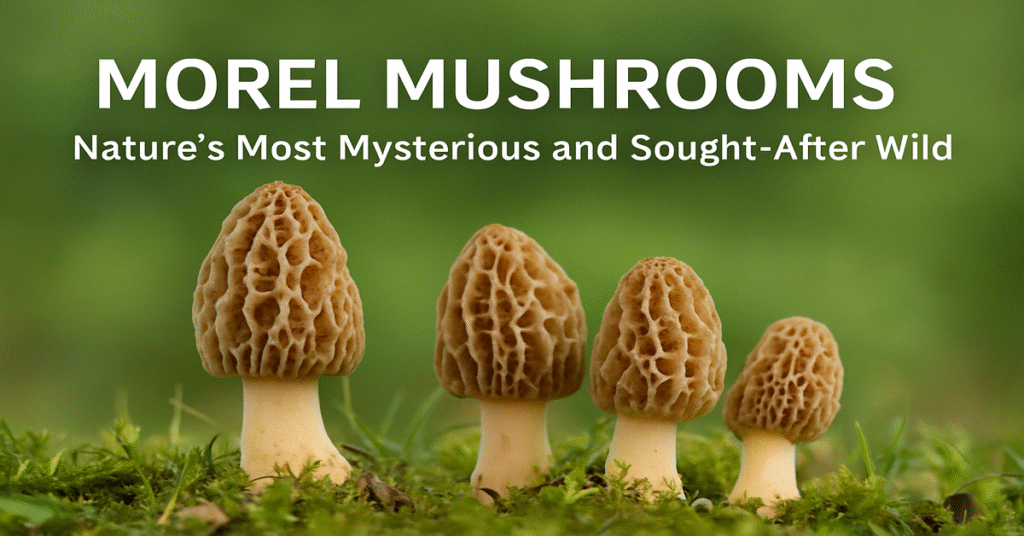Morel mushrooms are among the most highly prized wild edibles in the world. Known for their distinctive honeycomb appearance, rich earthy flavor, and elusive growth patterns, morels hold a mythical place in the hearts of foragers, chefs, and mycologists alike.
Belonging to the genus Morchella, morels are considered gourmet mushrooms and fetch high prices in markets due to their rarity and complexity of cultivation. Yet, beyond their culinary reputation, these fungi also present fascinating biological, ecological, and cultural stories worth exploring.
This article takes a deep dive into everything you need to know about morel mushrooms—covering their characteristics, types, growth conditions, harvesting, preparation, folklore, and even sustainability concerns.
Understanding What Morel Mushrooms Are
What Makes a Morel a Morel?
Morels are part of the fungal family Morchellaceae and differ from the typical mushrooms you may find at grocery stores. Their hollow, cone-shaped caps covered in pits and ridges are key identifiers, distinguishing them from look-alike fungi.
Anatomy of a Morel
- Cap: The cap is sponge-like, pitted, and attached directly to the stem. Its unique structure aids in spore dispersal.
- Stem: Cream to white in color, hollow inside, and attached at the base of the cap.
- Color: Ranges from pale cream to yellow, brown, or nearly black depending on the species.
Types of Morel Mushrooms
Black Morels (Morchella elata, Morchella angusticeps)
These are among the earliest morels to emerge in spring. Known for their darker caps and deep ridges, they often thrive near coniferous forests or areas disturbed by fire.
Yellow Morels (Morchella esculenta)
These are the most commonly foraged morels and preferred by chefs for their size and taste. Their caps are more rounded and paler in color.
Half-Free Morels (Morchella semilibera)
As their name suggests, these have caps that are only partially attached to the stem. Though edible, they are less desirable due to their smaller size.
False Morels (Genus Gyromitra)
Though not true morels, false morels are often mistaken for them. Some species contain toxic compounds and can be dangerous if consumed, highlighting the need for accurate identification.
Life Cycle and Ecology
The Fungal Network: Mycelium
What you see above ground—the morel—is just the fruiting body. Below the soil lies a vast network of fungal threads known as mycelium, which plays a crucial role in nutrient cycling and symbiosis with tree roots.
Conditions for Fruiting
Morels typically emerge in spring when:
- Soil temperatures reach 50–60°F (10–15°C)
- Ground is moist but not overly saturated
- Trees are budding or newly leafed
They often appear 7–14 days after a good spring rain, particularly after warm days followed by cool nights.
Associations with Trees
Morels often have mycorrhizal relationships with hardwoods like:
- Ash
- Elm
- Oak
- Poplar
- Apple (in old orchards)
They also appear in disturbed areas like forest burns, logging sites, or recently tilled land.
Where and When to Find Morel Mushrooms
Geographic Distribution
Morels are found across North America, Europe, and parts of Asia. In the U.S., they are most common in the Midwest, Northeast, and parts of the Pacific Northwest.
The Seasonal Window
In most regions, morels appear in early to mid-spring, usually between March and May, depending on latitude and elevation.
Ideal Foraging Spots
- South-facing slopes (early in the season)
- Deciduous forests with rich, loamy soil
- Burn sites (often produce bumper crops 1–2 years post-fire)
- Edges of rivers or streams
Tips for Foraging Morels
Know Before You Go
- Field Guide: Carry a reliable mushroom ID guide.
- Respect Property: Always get permission before foraging on private land.
- Sustainable Practices: Cut or pinch mushrooms at the base to allow mycelium regeneration.
Foraging Tools
- Mesh bag (helps disperse spores)
- Small knife or scissors
- Walking stick (helps spot mushrooms under leaves)
- GPS or phone for location marking
Safety First
- Never eat wild mushrooms unless you’re 100% sure of the ID.
- Avoid areas near industrial pollution or roads due to potential contamination.
- When in doubt, consult a local mycologist or mushroom club.
Cooking and Eating Morel Mushrooms
Cleaning and Preparation
Morels can harbor dirt, bugs, or grit in their crevices.
- Soak briefly in cold salted water
- Rinse gently and pat dry
- Never eat raw—they must be cooked
Flavor Profile
Morels have a deep, earthy, nutty flavor with a tender yet meaty texture. They absorb flavors from butter, cream, and aromatics beautifully.
Popular Recipes
- Sautéed Morels with Garlic and Butter
- Morel Cream Sauce over Steak or Pasta
- Stuffed Morels with Cheese or Meat
- Morel Risotto
- Morel Mushroom Soup
Drying, Storing, and Preserving
Drying Morels
Drying is a popular preservation method that intensifies flavor.
- Use a dehydrator or air-dry on a screen
- Store in airtight containers away from light
- Rehydrate with warm water or broth before use
Freezing
Morels can also be frozen after cooking. Avoid freezing raw morels, as they become mushy and lose flavor.
Cultivating Morel Mushrooms
Can You Grow Morels at Home?
Morels are notoriously difficult to cultivate commercially due to their complex and poorly understood life cycle. However, there are experimental methods:
- Inoculated spore kits
- Wood chip beds
- Controlled indoor environments (with mixed success)
Challenges in Cultivation
- Specific soil and temperature conditions
- Symbiotic tree relationships
- Unpredictable fruiting patterns
Commercial-scale cultivation is rare, which contributes to their high market value.
Economic and Culinary Value
Market Prices
Morels are among the most expensive mushrooms, often fetching:
- $20–$50 per pound when fresh
- $150–$200 per pound when dried
Their scarcity and labor-intensive foraging process drive up prices.
Culinary Prestige
Top chefs consider morels a delicacy. They frequently appear on seasonal fine dining menus and in gourmet products such as:
- Truffle and morel pastes
- Wild mushroom blends
- Infused oils and sauces
Folklore, Traditions, and Cultural Significance
A Symbol of Spring
In many cultures, morels are a harbinger of spring and renewal. Annual festivals in morel-rich towns celebrate the season’s first harvest.
Indigenous and Traditional Knowledge
Native American and First Nations communities have long harvested wild mushrooms, often blending this with knowledge of plant medicine and forest ecology.
Folk Beliefs
Morels have often been believed to:
- Grow best near lightning-struck trees
- Emerge where deer or turkeys frequent
- Be favored by forest spirits or woodland deities
While these are myths, they reflect the reverence morels inspire.
Environmental and Conservation Considerations
Sustainability of Wild Harvesting
Morels regenerate through underground mycelium, and with proper harvesting techniques, their populations can remain stable. However:
- Overharvesting in popular locations is a concern
- Burn sites can be damaged by careless foragers
- Habitat loss impacts long-term availability
Best Practices for Conservation
- Limit collection per person
- Use mesh bags to disperse spores
- Avoid trampling sensitive forest areas
- Educate new foragers about ethics and safety
Scientific Interest and Research
Morel Biology
Scientists are still unraveling the genetic and biochemical pathways that drive morel fruiting. Their classification and taxonomy are also still under debate, with ongoing DNA studies reshaping how we understand Morchella.
Medicinal Potential
Early studies suggest morels may have:
- Antioxidant properties
- Anti-inflammatory compounds
- Possible immune-supporting benefits
While not as extensively studied as other mushrooms like reishi or lion’s mane, morels hold untapped potential in fungal medicine.
Conclusion
Morel mushrooms represent the perfect intersection of mystery, ecology, gastronomy, and tradition. Their brief seasonal appearance makes them a treasure to be anticipated each year, and their flavor cements them as a culinary legend. Whether you’re a curious forager, an aspiring chef, or a nature enthusiast, understanding morels means stepping into a deeper connection with the forest, the seasons, and the hidden marvels of the fungal kingdom.
Their elusive nature teaches patience, their flavor rewards the effort, and their story reminds us that some of the finest things in life remain just a little wild.
FAQs
1. Are all morel mushrooms safe to eat?
Only true morels are safe when properly cooked. False morels, which look similar, can be toxic. Always use reliable identification methods and consult a guide or expert.
2. Can I find morel mushrooms in my backyard?
It’s possible! If you have old apple trees, elms, or a moist wooded area with rich soil, morels might appear in spring.
3. How should I clean morels?
Soak briefly in cold salted water to remove bugs and dirt. Rinse gently and pat dry. Avoid soaking for too long to prevent sogginess.
4. Can I grow morels at home?
Morels are very difficult to cultivate. While home grow kits exist, success is not guaranteed due to their complex growth requirements.
5. What do morel mushrooms taste like?
Morels have a rich, earthy, nutty flavor with a meaty texture. They pair well with butter, cream, garlic, and wine sauces.
6. Why are morels so expensive?
Their short season, labor-intensive foraging process, and difficulty in cultivation make morels a rare and high-demand gourmet mushroom.







